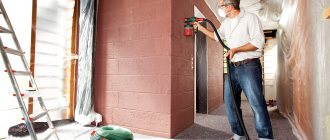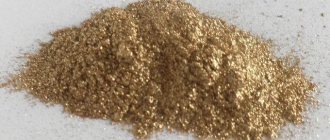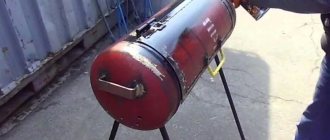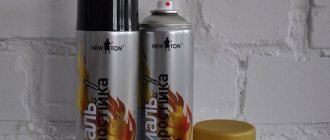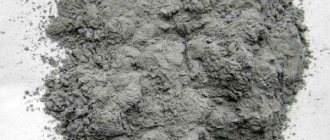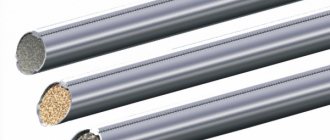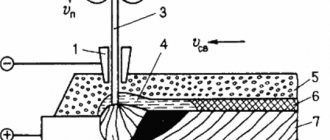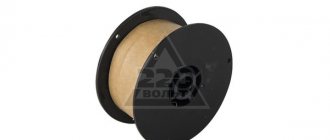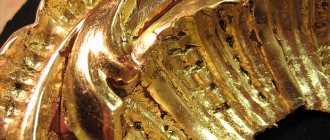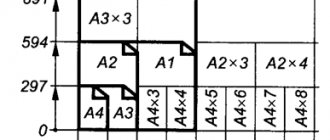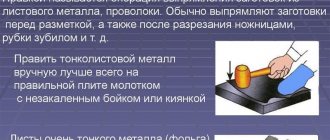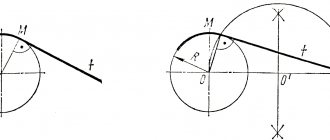Powder painting is a modern technology that allows you to achieve a reliable and durable coating on almost any surface. Application is not particularly difficult if you have the skills, but requires the use of special equipment. The peculiarity of this method is that painting occurs in a dry manner, and a protective layer is formed during subsequent heating.
The essence of the method
Powder coating technology allows you to obtain the thinnest layer of polymer on the metal, looking integral with the surface. In industrial production, iron is painted using this method. It is used to process mechanical parts, forged products, furniture, entrance doors, and household appliances.
First, the metal is uniformly coated with dry powder particles using a spray gun connected to a voltage source. They are supplied under pressure along with the air flow and are held on the surface due to electrostatic attraction. Next, in special ovens under the influence of elevated temperatures or chemical activators, the paint polymerizes. As a result, a thin but very durable film is formed.
Powder coating of metal products allows you to obtain a coating that is not afraid of even significant temperature changes and exposure to ultraviolet rays. It is not so easy to scratch or damage the polymer film in any other way, even during transportation. And it looks unusually decorative.
DIY powder painting technology
The spraying chamber must have a closed space with ventilation, an air heating system and a high-quality power supply network.
It is important that the spray chamber is very clean and free of dust. Wash it thoroughly and buy a vacuum cleaner. The more powerful it is, the better. It is desirable that it have a nozzle similar to a “cyclone”.
To carry out high-quality powder painting, you need to purchase a good gun designed for this technology, with a pressure of about five atmospheres.
If you wish, you can make a gun with your own hands from an ordinary hairdryer.
You can purchase a polymerization oven; there is a choice on the market, but if you need to save money, you can make it yourself.
When you have prepared everything you need, you can start powder coating the product.
This technology requires compliance with the following safety measures:
- working ventilation;
- gloves made of rubber or cotton, the soles of shoes should be rubberized;
- eye protection goggles;
- for safe operation of the spray gun there must be grounding;
- a respirator is required.
Note that unprofessional implementation of this painting technology often does not give the expected results, as coating defects form.
Types of powder paints
They are divided according to the methods of film formation on the surface. There are two main groups of such paints:
- thermoplastic: the coating is formed under the influence of high temperatures of 150-200°C due to melting and further hardening of the powder.
- thermosetting: applied using chemical acrylic, epoxy or polyester reagents.
The second method is more common in industry. Coatings applied using thermosetting reagents are not afraid of prolonged heat and exposure to the sun. Powder coating of metal products at home is often done using a thermoplastic method.
What equipment is needed for powder painting?
Powder painting technology is problematic to carry out independently precisely because of the need to have special expensive equipment, namely:
- Sandblasting
We highly recommend finding it. Of course, it is possible to replace sandblasting with some kind of abrasive, but this will affect the quality of the work performed, especially if the surface of the product has a complex, angular shape.
Do not buy a professional tool if you plan to sandblast yourself. Opt for a low-feed gun that can take sand from a container. It will be quite sufficient for the implementation of this technology.
Attention! Sandblasting only works with special fine, purified sand. You can replace it with river sand, after carefully sifting it through a sieve.
The sandblast itself visually resembles a spray gun. The technology of its operation is as follows: under the influence of high pressure, sand enters the nozzle of the gun. This device allows you to process hard-to-reach areas of surfaces. The great advantage of this device is its deep removal of dirt; it effectively cleans numerous micropores of metal products.
Sandblasting ideally prepares the surface for further smooth coating using powder painting technology.
- Spray gun
Powder painting technology requires a special spray gun. Its feature is as follows: an electric wire is connected to the nozzle of the gun, which charges the coloring particles.
Ground is another wire that, in accordance with technology, comes into contact with the product being painted. This contact leads to a micro-circuit, due to which paint particles penetrate into the metal.
- Polymerization chamber
A polymerization chamber is needed to spray the coloring powder onto the product. It must be sealed and equipped with special equipment. The camera must contain:
- doors to ensure tightness, preventing dust from entering the chamber;
- bright lighting. Lamps must be placed throughout the chamber (on ceilings, walls, floors);
- forced exhaust hoods, which will remove particles of dust and paint that do not fall on the surface to be painted;
- catch filters, which are located in hoods and trap particles of paint that do not fall on the product; it can be used again when implementing powder painting technology.
Attention! Filters can capture up to 5% of the paint that does not reach the surface, so if you are planning to make a polymerization chamber yourself, purchase them and thereby you will save money. Don't forget that powder paint is not cheap.
Powder coating technology in small private organizations is often carried out in chambers that are unlikely to meet all the requirements. Usually in such cases they are a very clean room with sufficient lighting and good exhaust.
Dear readers!
If you have any questions about development and production:
➜ housings for electronic equipment;
➜ housings for monitors and LED displays;
➜ shielding structures for electronic devices.
Call: +7(495) 642-51-25
or leave a request. We will answer all your questions! It's absolutely free!
Powder painting technology provides good lighting. It is unacceptable for the chamber to have dark areas with poor light, since the master must see whether the paint is applied evenly, otherwise even a small smudge can greatly spoil the overall appearance of the product. When applying colorless varnishes, the lack of light is especially acute, which should not be the case.
Polymers are a coloring substance that is provided by powder painting technology. If a person has not encountered such technology before, he is unlikely to immediately understand how a durable coating is formed on the surface, especially since solvents are not used in the process.
Powder painting technology is polymerization, which is carried out in a special chamber heated to a certain temperature, maintaining the desired degree for the required time.
Here is a table that clearly shows what temperature should be in the chamber, as well as how long the product needs to be kept in it, depending on the layer of paint.
| Paint layer | Chamber temperature (°C) | Curing time (min.) |
| 1 layer. Priming | 130–140 | 20 |
| 2nd layer. Dye | 160–180 | 40 |
| 3 layer. Varnish | 200–220 | 90 |
| Total | Average temperature 160 | 150 minutes or 2.5 hours |
Required materials and equipment
So, let's give a detailed description of the technology of powder coating of metal. To create a durable coating layer on it you will need:
- oven (chamber) for polymerization: you can make it yourself or purchase it in a specialized store;
- spray gun: since such a device costs a lot, it can also be assembled from a converter, often used in lighters for gas stoves, a power supply and an ordinary plastic bottle;
- naturally, the paint itself.
Drying ovens will need to be connected to a voltage source of 25 kW. In operation it will produce 6 kW, while warming up a little more - 12 kW. To make it, you will need thick sheet metal for the housing, heating elements, a tangential fan in which air masses will move in one direction, as well as any non-flammable heat insulator for the casing.
The heating elements are placed parallel to each other on opposite walls of the furnace. The main part of the fan is mounted outside the chamber. It is welded in such a way that the exit is narrow and the entrance is wide enough. It is also necessary to make a separate chamber for spraying in the drying oven. For processing large parts, it is better to provide rail-type trolleys.
Advantages and differences of polymer powder coatings from traditional paints
Powder-polymer painting is different:
• high coloring speed; • absence of mandatory second painting and preliminary priming; • economical painting; • wide range of coating thickness and high adhesion; • the paint does not leave streaks on vertical surfaces; • stands out for its resistance to bending and impact; • resistant to corrosion and abrasion; • exhibits high resistance to weathering and chemistry; • resistant to temperature changes; • opens up opportunities for creating coatings that have modern electrical insulating, chemical, physical-mechanical, protective and decorative properties; • decorative painting; • environmentally friendly coating, because there are no toxic or flammable solvents, which eliminates the problem of safety and environmental protection.
The Ministry of Health has certified powder paints, which is why powder-polymer coating becomes especially attractive and is used in the production of medical and food equipment, and household appliances.
Surface preparation
This stage is considered the most important. The technology of powder painting of metal products involves complete cleaning of the surface from rust and dirt. If there are even the smallest traces of corrosion, the coating will simply crumble.
The surface should be cleaned with sandpaper or a metal brush until it shines, so that not even the smallest rusty speck remains. To remove a significant layer of corrosion, etching with hydrochloric or sulfuric acid is used. The old layer of paint or blackening is also completely removed. For this purpose, a special wash is used.
After complete stripping, the metal must be degreased with a solvent. Next, to increase adhesion (adhesion to paint), the surface is primed. The last stage is passivation, that is, treatment with a mixture of sodium and chromium nitrate to protect against corrosion.
Pros and cons of powder coating
Among the main advantages of powder coating technology, most engineers and industrialists name those presented below.
This:
- minimizing the number of painting passes, resulting in increased productivity and reduced production costs;
- environmental friendliness of production and improvement of working conditions - even in the oven during the thermal polymerization process, the concentration of harmful volatile compounds does not exceed the norm;
- absence of solvents, resulting in a coating without micropores and cavities, and its shrinkage is minimal;
- economical consumption of powder paint and no need for expensive maintenance of production facilities for drying painted products;
- extremely low degree of fire and explosion hazard;
- high hardness of the coating, which reduces packaging costs and ensures reliable protection of metal products during transportation;
- resistance to a wide range of aggressive environments and fuels and lubricants;
- resistance of the pigment and polymer base to the destructive effects of ultraviolet radiation;
- wide palette - more than 5000 colors, shades and textures.
The powder coating technology also has a number of disadvantages, the main one of which is the inability to paint plastic and wooden products due to the high baking temperature during the polymerization process.
Other disadvantages include:
- difficulty in applying a thin layer;
- narrow specialization of equipment for - in large ovens it is unprofitable to paint small non-serial products and vice versa;
- the need to use a separate container for each color and shade;
- difficulty in applying coating to metal products of complex geometric configurations and composite structures;
- serious investment in the construction of a painting line;
- no possibility of tinting - only a standard palette is used.
Another disadvantage of metal powder painting technology is the impossibility of local elimination of defects and holes in the applied coating. When such gaps appear, you have to remove the paint and apply the powder composition, followed by baking again.
Applying paint
The process is quite simple. We place the required part in the spraying compartment and connect the spray gun to the power source.
- The dry powder is applied evenly using a sprayer. To do this, it is necessary to keep the tool at the same distance from the surface during the entire processing time.
- Dry particles of paint under the influence of electrical voltage will themselves stick to the surface. If there is enough of it, small sparks should appear when you bring the bottle with a metal stopper closer than 20-30 mm.
- Please note that mixing several types of powder to obtain the desired shade is not recommended. The color will be uneven.
- The collection of powder residues in production conditions is carried out using special equipment - a recuperator. At home, you can use a cyclone vacuum cleaner. It is better to lay newspapers on the floor in advance.
Polymerization or baking
The painted metal product is placed in the oven. In it, under the influence of constant temperature, the part is heated and the paint polymerizes. The particles fuse to form a film, then harden and cool. The whole process takes about 15–30 minutes. Curing time depends on the size of the product and the type of oven.
The temperature in the polymerization chamber is kept within 150-200 0C and depends on the type of paint. The molten powder is able to fill all micro-irregularities, which gives good adhesion to the metal surface.
The paint receives all the necessary properties at the hardening stage: strength, appearance, protection. After this, the product should cool for 15 minutes. Otherwise, the coating may be damaged and dust and dirt may adhere to it.
Main stages of coloring
Let us describe in detail the technology of applying powder paint to metal:
- The stove should be installed in a room with forced exhaust. All work is carried out in a protective suit, gauze bandage or respirator and goggles.
- For lighting you will need fluorescent lamps. You should not use ordinary light bulbs - the smallest particles of powder will be attracted to them.
- Products coated with dry paint are placed in the oven for half an hour. They should be mounted on a frame that has grounding.
- Achieving uniform heating of different types of parts at home is not easy. To obtain a monolithic and durable polymer film, the temperature will have to be selected experimentally each time.
- For each type of paint, there are special recommendations described in the manufacturer's instructions, including the exact polymerization time. It must be strictly observed.
- The main difficulties arise when painting parts of different sizes. Each of them may require a separate oven.
- No additional processing is required. After cooling and curing for 24 hours, the painting is considered complete. Drying is done in the usual way in the open air.
- For painting large items, you can use a gun with a propane torch. The dry powder, passing through it, is immediately melted and supplied in a semi-liquid state. The part being painted does not heat up.
Thus, applying powder paint to metal even at home is quite possible. This method can be used to process not only iron, but also tempered glass, which can withstand temperatures of 150-200°C.
Bottom line
Powder coating is the most economical, fastest and environmentally friendly way to obtain a reliable protective surface on metal. The service life of the product is significantly increased, and the decorative coating can be varied not only in color, but also in structure.
The difficulties of the technology lie in strict adherence to all stages. This requires a special production line. Problems may arise when:
- painting large items;
- products of complex shape;
- structures made of mixed materials.
The dry method has undeniable advantages over other types of staining:
- waste-free;
- variety of paints by cost and properties;
- high physical and mechanical properties of the painted metal surface.
For these reasons, powder coating has become one of the most popular modern methods of protecting metal from damage.
Dry painting equipment
In powder coating, applying the paint is not the final step. In order for the polymer to adhere to the surface, it is heated in ovens. The powder coating line consists of:
- chambers for applying powder. In this sealed chamber, the coloring agent is applied to the metal;
- electrostatic sprayer for applying powder. Thanks to static electricity created by a high voltage source, paint is evenly applied to structures of any shape;
- polymerization chambers. It provides a constant temperature and is equipped with a ventilation system. In it, the process of paint polymerization and its uniform distribution over the product takes place;
- compressor. It is designed to create a certain pressure in the painting chamber;
- devices for transporting metal products. Heavy and large painted products must be transported carefully so that the powder does not fall off. This is provided by special carts moving along the monorail.
Difference in composition
In terms of their structure, powder mixtures consist of solid particles of the dispersion type, which, together with pigments, are the basis for the material. To improve properties, film-forming resins, acrylates, hardeners and other fillers are added. The main difference from enamels is the complete absence of solvents. It is the solvent that makes the paint dangerous in terms of toxicity and the possibility of fire. Powder materials meet special requirements, in particular, the powder must be free-flowing and maintain a dry form.
Dry mixtures should not stick to surrounding foreign objects or form clumps for a long time. In fact, the material is already ready for use, since there is no need to add solvents. As for emulsion paints, it is a system of two immiscible liquids. Polymer-type paints in water consist of small globules, synthetic resin or rubber, emulsifier, pigment and other additives. Among liquid materials, styrobutadiene polymer paints can be distinguished, which contain a pigment in latex, a thickener, and an emulsifier. Before application, water or solvent is always added to such paints to give the material the desired viscosity.
